
Classic Buses Profiles
Maidstone and District AEC Regals (by Dick Gilbert)
Last updated 11 February 2022

SOME LINKS WITHIN THIS WEBSITE:
Home
Email
Links
THE COMPLETE WEBSITE MENU
Events Diary
Halfcab list
Small-Ads
Classic Irish Buses
Classic Manx Buses
This page is dedicated to the extensive fleet of AEC Regals operated by Maidstone and District Motor
Services in Kent and Sussex both before and after the second world war.
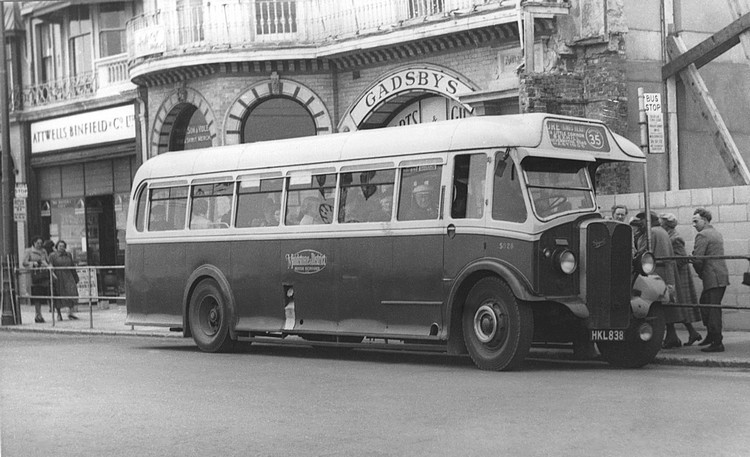
A classic example of the typical post-war Maidstone and District single deck bus, a 1947 Regal no.
SO28 (HKL 838) with Beadle bodywork. It is operating on route 35 along the Sussex coast between Bexhill and Hastings, on a sunny
but blustery day in the 1950s. Damage is apparent to the building on the right, no doubt from the many coastal hit and run raids
that beset south coast towns during the war. Photo: Roy Marshall, by permission of the Bristol Vintage Bus Group.
INTRODUCTION AND CREDITS
Maidstone and District operated over 200 AEC Regals over the years, most of the pre-war examples
being acquired from the various companies taken over during the 1930s. They appeared as buses and coaches, and in many forms and
styles. What follows is an attempt to create a brief history of the type, in the form of records and images designed to give even
the casual reader some impression of the development and classic styling of this extensive fleet.
Maidstone and District Motor Services started by operating four second-hand buses to Chatham in
1908, and by the outbreak of World War 1 the fleet had grown to eleven. In 1922 they built what was to be the first bus station
in the country, at Palace Avenue, Maidstone, and by the end of the decade the company had opened seven depots throughout the area,
from Bexhill to Ashford, and as far afield as Dartford and Sheerness.
A large number of local companies were acquired in the following years, including the absorption in
1933 of Autocar of Tunbridge Wells, some of whose splendid AEC Regals joined the fleet and are described in detail below. In 1935
M and D got into the trolleybus business by gaining control of the Hastings Tramway Company, a service they maintained until 1959.
A very extensive express coach network was established, linking London with towns all over west
Kent, the Medway towns and parts of Sussex, as well as providing connections between towns throughout that area. A fine fleet of
coaches was acquired for that purpose. During the second world war, its fleet of express coaches had to curtail operations, and
many were converted to ambulances for emergency duties.
Services recommenced in 1946, and new vehicles were purchased to replace the ageing, and sometimes
war-worn pre-war fleet. During the 1950s smart Maidstone and District coaches and single-deck buses could once again been seen
operating regular routes, express services, private hires and excursions, all over the south-east of England and beyond. Some
might say that this was their finest hour.
By the mid 1960s the pre-war fleet had all but disappeared, and halfcab buses of all kinds were
considered dated. New single-deck equipment was arriving, largely in the form of the AEC Reliance, and the proud fleet of halfcabs
had either been scrapped or passed to downstream operators for their twilight years. We are fortunate to have a few survivors in
preservation today. Sadly the Maidstone and District name is no more, having been assassinated by Arriva after more than 80 years
of fine service to the people of Kent and East Sussex.
Maidstone and District vehicle identification changed over the years. Originally only fleet numbers
were used, although certain express coaches seem to have been given the prefix EX. In 1950 coaches were given the prefix CP for
Coach, Petrol, and CO for Coach, Oil (i.e. diesel engined). Similarly single-deck buses became SP and SO. By 1961, as there were
no petrol engined vehicles left in service, it was decided to change SO simply to S, and CO to C. Subsequently prefixes were
dropped altogether, and the system reverted to the use of fleet numbers only.
Owners of pictures, when known, are credited, and their use is much appreciated. However the
photographers of some pictures are not shown on the original photograph, and therefore are not known to me. Whoever they were I
thank them, and if they contact me with their names they will of course be credited. If a rightful owner wishes me to remove any
image, it will be done forthwith. However I hope that photographers (or copyright holders) will permit the use of these fine
pictures in their proper context.
All batches are arranged in order of delivery (including those delivered originally to other
operators).
As with my other lists, there are bound to be mistakes, and some relevant information may be
missing so, in order to make it as accurate a reference as possible, I would of course welcome any additions or corrections.
FLEET LIST
AEC REGAL 1 BUS - 121 (Total 1)
Built in 1929, acquired by M. and D. from Timpson's in 1934.
Chassis: AEC Regal 662 (6-cylinder petrol engine).
Body: AEC B32F (sometimes recorded as an LGOC body, and also as C32R)
Notes: Acquired by Maidstone and District from Timpson's (Hastings branch) in March 1934.
Previously Timpsons no. 190.
- 121 (UW 8592) c/n 662014, new to Timpson's 12/29. Commercial Motor Show exhibit 1929. To M and D 3/3/34. To Lawson (dealer), London 5/37.
AEC REGAL 1 COACHES - 25-52 (Total 28)
Delivered 1930-1931 to East Surrey. Transferred to Autocar, Tunbridge Wells when that company
became an M. and D. subsidiary in July 1933. Absorbed into the M. and D. fleet at various dates.
Chassis: AEC Regal 662 (6.1 litre, 6-cylinder petrol engines).
Body: Original LGOC-style bodies as follows; 25-29 Hall Lewis B30R, 30-31 Park Royal B30F, 32-43
Hall Lewis C29D, 44-52 were Park Royal C29F. Many were later rebodied by Harrington as C32F at various dates.
Notes; Although originally delivered to East Surrey, these coaches were acquired from the fleet of
Autocar, Tunbridge Wells when that company was absorbed by Maidstone and District on 1st July 1933.
Twenty one were allocated LGOC numbers T325-T345 in January 1932, for the Green Line service from
Oxford Circus to Tunbridge Wells (Autocar had been part of the LGOC group). However they did not go into service with Green Line
as such, operating under East Surrey or Autocar names on contract to Green Line, and most of the vehicles were transferred to
Maidstone and District on 1st July 1933. This was in order to rationalise some services on the edge of the Maidstone and District
area following the formation of London Transport in 1933.
25-43 were new in 1930 (except 30 and 31 which dated from 1931), and came to Maidstone and District
from Autocar in July 1933, while 44-52 were new in 1931, and were acquired by M. and D. in March 1934 in exchange for rebodied
1926/27 Tilling-Stevens vehicles (nos. 400, 404, 407, 411, 419, 421, 422, 427, 442) that had originally been charabancs. Autocar
was run as a separate company until May 1935 when the fleet became part of the main M. and D. inventory.
Most were rebodied by Harrington (as coaches) at various dates in 1937, 1938 and 1946, and all
those that survived the war were redesignated CP25-49 in 1950.
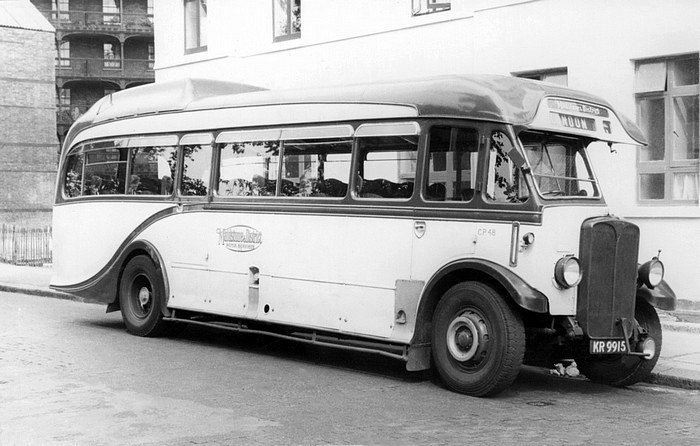
Glorious ex-Autocar 1931 AEC Regal CP48 (KR 9915), probably resting near Victoria Coach Station
around 1950 after an express run up from Kent. It wears the upgraded body fitted by that classic coachbuilder, Harringtons of
Hove in 1946. (Photo: Roy Marshall, by permission of the Bristol Vintage Bus Group)
- 25 (KR 2921) New 4/30, c/n 662237. To Autocar as no. 107, Hall Lewis B30R (or C30F?). To Harrington C32F 5/37. Used as an ambulance during WWII. Became CP25 in 1950. Sold to Clark (dealer) Paddock Wood 12/52. With showman, Tooting 4/53. With showman, Clapham 4/68. With V. E. Blackmore, Westcliff-on-Sea 1/71 and used for spares.
- 26 (KR 2922) New 4/30, c/n 662238. To Autocar as no. 108, Hall Lewis B30R (or C30F?). To Harrington C32F 5/37. Used as an ambulance during WWII. Became CP26 in 1950. Sold to Clark (dealer) Paddock Wood 2/53. F. Smith, Dorking 7/53 as mobile cafeteria. Caravan at East Croydon 7/55.
- 27 (KR 2923) New 3/30, c/n 662150. To Autocar as no. 109, Hall Lewis B30R. To Harrington C32F 5/37. Used as an ambulance during WWII. Became CP27 in 1950. Withdrawn 1952. Sold to Clark (dealer) Paddock Wood 3/53. Kemp, Baughurst 6/53. Crescent Coaches, Camberley 6/53. With showman, Bushey 8/58.
- 28 (KR 2924) New 3/30, c/n 662130. To Autocar as no. 110, Hall Lewis B30R. To Harrington C32F 5/37. Used as an ambulance during WWII. Became CP28 in 1950. Sold to F.Chaney (dealer), Rainham, Kent 10/52. To Olsen, Strood. Caravan at Dunsfield 9/55.
- 29 (KR 2925) New 3/30, c/n 662153. To Autocar as no. 111, Hall Lewis B30R. To Harrington C32F 5/37. To the Army 6/41. Later to Mountain Transport, Forest Hill. With Robinson, Burbage 1952. With showman, Wolverhampton 1956.
- 30 (KR 9919) New 3/31, c/n 662915. To Autocar as no. 152, Park Royal {B3038} B30F. To Harrington C32F 5/37. Used as an ambulance during WWII. Became CP30 in 1950. Sold to Clark (dealer) Paddock Wood 7/53. Hooper, Maidenhead by 6/55.
- 31 (KR 9920) New 3/31, c/n 662916. To Autocar as no. 153, Park Royal {B3039} B30F. To Harrington C32F 5/37. Used as an ambulance during WWII. Became CP31 in 1950. Sold to Clark (dealer) Paddock Wood 1/53. Later to showman.
- 32 (KR 3031) New 3/30, c/n 662160. To Autocar as no. 112, Hall Lewis C29D, allocated Green Line no. T325. To Harrington C32F 2/38. Became CP32 in 1950. Sold to Penfold (dealer) 10/52. With showman 5/53 and 1954.
- 33 (KR 3238) New 4/30, c/n 662240. To Autocar as no. 115, Hall Lewis C29D, allocated Green Line no. T327. To Harrington C32F 3/38. Body destroyed by bomb 5 Dec 1940, and rebodied Harrington C32F 7/41. Became CP33 in 1950. Sold to Clark (dealer) Paddock Wood 7/53. With showman, Worthing 8/54. Showman, Ewell 11/59.
- 34 (KR 3561) New 4/30, c/n 662241. To Autocar as no. 116, Hall Lewis C29D, allocated Green Line no. T328. To Harrington C32F 3/38. Became CP34 in 1950. Sold to Clark (dealer) Paddock Wood 1/53. With showman, Dartford 6/54. Forrest's Fair in North Kent 5/55 and 1959. Scrapped Gravesend 11/59.
- 35 (KR 3562) New 4/30, c/n 662242. To Autocar as no. 117, Hall Lewis C29D, allocated Green Line no. T329. To Harrington C32F 3/38. To the Army 6/41. By 1948 with Bloomfield (Sheenway Coaches), London SW14, re-registered KPO 460.
- 36 (KR 3563) New 4/30, c/n 662123. To Autocar as no. 118, Hall Lewis C29D (or C29F?), allocated Green Line no. T330. To Harrington C32F 2/38. Became CP36 in 1950. Sold to Clark (dealer) Paddock Wood 1/53.
- 37 (KR 3564) New 4/30, c/n 662218. To Autocar as no. 119, Hall Lewis C29D, allocated Green Line no. T331. To Harrington C32F 2/38. Became CP37 in 1950. Withdrawn 1952, sold to Clark (dealer) Paddock Wood. With showman, Tooting 4/53 and noted again 4/54. Caravan by 1959.
- 38 (KR 3565) New 4/30, c/n 662221. To Autocar as no. 120, Hall Lewis C29D, allocated Green Line no. T332. To Harrington C32F 3/38. Became CP38 in 1950. Sold to Parkis (dealer) London 7/52. With Boughton, London E2 8/52, withdrawn 6/54.
- 39 (KR 3566) New 4/30, c/n 662239. To Autocar as no. 121, Hall Lewis C29D, allocated Green Line no. T333. To Harrington C32F 2/38. Became CP39 in 1950. Sold to Clark (dealer) Paddock Wood 2/53. Body fitted to Leyland TD7 CDW 960 (ex Newport Corpn. 93) by Heaver's, Durrington, and to Marston Coaches, Oxford 5/54.
- 40 (KR 3567) New 4/30, c/n 662243. To Autocar as no. 122, Hall Lewis C29D, allocated Green Line no. T334. To Harrington C32F 3/38. Became CP40 in 1950. Sold to Clark (dealer) Paddock Wood 1/53. Body fitted to Leyland TD7 CDW 961 (ex Newport Corpn. 94) by Heaver's, Durrington, and to Marston Coaches, Oxford 5/54. With Tulk, Swansea 6/56, withdrawn by 6/57.
- 41 (KR 3568) New 4/30, c/n 662219. To Autocar as no. 123, Hall Lewis C29D, allocated Green Line no. T335. To Harrington C32F 2/38. To the Army 6/41.
- 42 (KR 3569) New 4/30, c/n 662223. To Autocar as no. 124, Hall Lewis C29D, allocated Green Line no. T336. To Harrington C32F 2/38. Became CP42 in 1950. Sold to Clark (dealer) Paddock Wood 1/53.
- 43 (KR 3237) New 4/30, c/n 662233. To Autocar as no. 114, Hall Lewis C29D, allocated Green Line no. T326. To Harrington C32F 2/38. Became CP43 in 1950. Sold to Clark (dealer) Paddock Wood 1/53.
- 44 (KR 9911) New 3/31, c/n 662913. To Autocar as no. 154, Park Royal {B3036} C29F, allocated LT no. T337. To M and D 5/34. To C31F with parcel rack 12/34. To Harrington {15} C32F 9/46. Renumbered CP 44 in 1950. To Shoulders (dealer) 12/55.
- 45 (KR 9912) New 3/31, c/n 662912. To Autocar as no. 155, Park Royal {B3035} C29F, allocated LT no. T338. To M and D 5/34. To C31F with parcel rack 2/35. To the Army 6/41. Later with Spratley Bros. Victory Coaches, Reading.
- 46 (KR 9913) New 4/31, c/n 662911. To Autocar as no. 156, Park Royal {B3034} C29F, allocated LT no. T339. To M and D 5/34 as no. 46. To C31F with parcel rack 2/35. To Ministry of Supply 6/41 for Ministry of Works & Buildings. To Superior Coaches, Tottenham 4/49 re-registered TMG 692 and rebodied Churchill C35F 12/48. Withdrawn 10/52, to Armstrong Whitworth, Baginton as staff bus by 1954.
- 47 (KR 9914) New 4/31, c/n 662910. To Autocar as no. 157, Park Royal {B3033} C29F, allocated LT no. T340. To M and D 5/34. To C31F with parcel rack 2/35. To Ministry of Supply / Ministry of Works 6/41. To Margo, Bexleyheath, 10/48 re-registered TMK 74 and new Strachans C35F body. To Townsend, Princes Risborough 8/56, to Collett's Garage, Wheatley 5/58, to Young's Coaches, Grays by 5/58.
- 48 (KR 9915) New 3/31, c/n 662909. To Autocar as no. 158, Park Royal {B3032} C29F, allocated LT no. T341. To M and D 5/34. To C31F with parcel rack 12/34. To Harrington {13} C32F 7/46. Renumbered CP 48 in 1950. To Shoulders (dealer) 12/55.
- 49 (KR 9916) New 3/31, c/n 662908. To Autocar as no. 159, Park Royal {B3031} C29F, allocated LT no. T342. To M and D 5/34. To C31F with parcel rack 12/34. To Harrington {14} C32F 7/46. Renumbered CP 49 in 1950. To Shoulders (dealer) 12/55.
- 50 (KR 9917) New 4/31, c/n 662907. To Autocar as no. 160, Park Royal {B3030} C29F, allocated LT no. T343. To M and D 5/34. To C31F with parcel rack 12/34. To Ministry of Supply / Ministry of Works 6/41. To Margo, Bexleyheath 10/48, re-registered TMK 74 and new Strachans C35F body 10/48. Withdrawn 1/56, with Kyle Stewart (contractor), London NW6 by 2/59, last licenced 1/60.
- 51 (KR 9918) New 3/31, c/n 662906. To Autocar as no. 161, Park Royal {B3029} C29F, allocated LT no. T344. To M and D 5/34. To C31F with parcel rack 12/34. To the Army 6/41. W E and L J Grundon, Eltham 6/48, and received new Beadle {652} C33F body 7/48. Belmont, Woodchurch 8/54.
- 52 (KR 9921) New 3/31, c/n 662914. To Autocar as no. 162, Park Royal {B3037} C29F, allocated LT no. T345. To M and D 5/34. To C31F with parcel rack 12/34. To the Army 6/41. With Ministry of Works by 7/44 numbered P61.
AEC REGAL 1 BUS - 867 (Total 1)
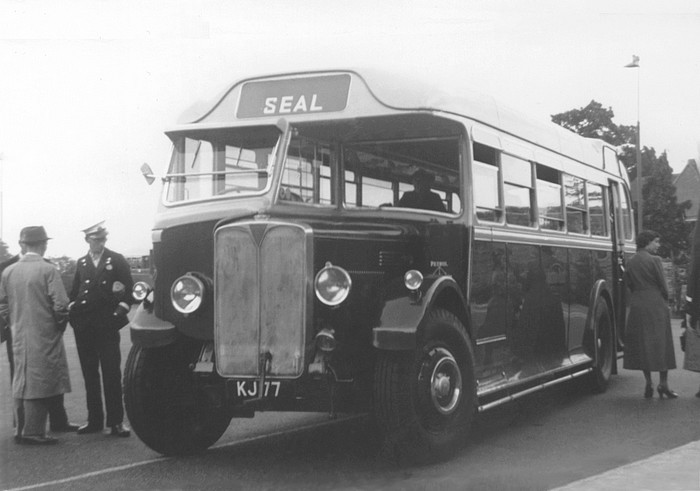
One-off AEC Regal no. 867 (KJ 77) is seen here wearing its later Harrington bus body, fitted in
1938, so probably the photo was taken in the late 1940s. Photo by kind permission of the
Omnibus Society, no. 91.1854.
Delivered new in April 1931, acquired by M. and D. in Nov 1933.
Chassis: AEC Regal 662 (6.1 litre 6-cylinder petrol engine).
Body: Original body Strachan and Brown C32R, broken up June 1938. Rebodied as Harrington B31R in
July 1938.
Notes: Acquired from Weald of Kent, Tenterden in November 1933 when their operations were taken
over.
- 867 (KJ 77) c/n 662637. New to EJ Mears (Venture Services), Sittingbourne 4/31, later to Weald of Kent, Tenterden, to M and D 1/11/33, new Harrington body fitted 7/38. Sold to G.Moss, Charing 11/50.
AEC REGAL 1 COACHES - 111-120 (Total 10)
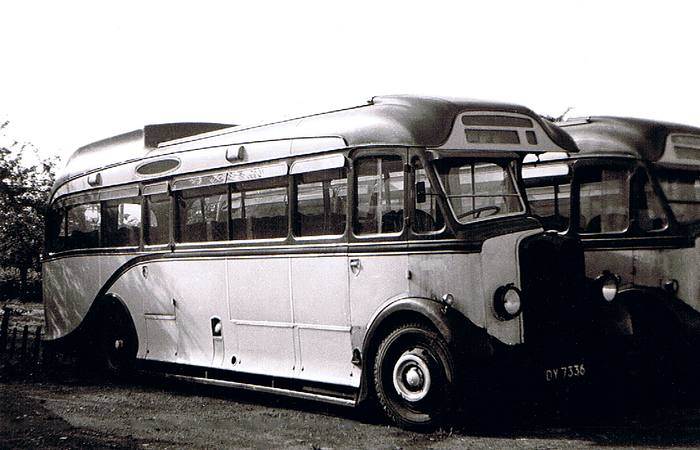
Regal no. 119 (DY 7336) possibly seen in the dealer's yard of Clark, Paddock Wood in 1953 after
withdrawal by Maidstone and District. Photo: unknown.
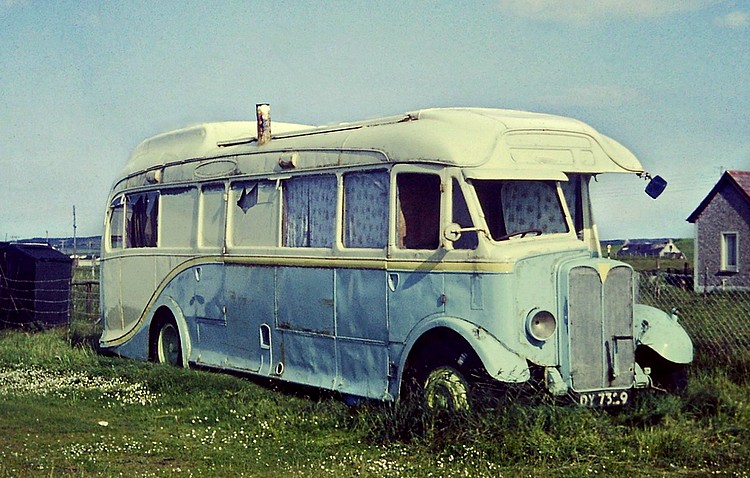
Regal no. 112 (DY 7329) when in use by a showman in Ireland, probably taken around 1960. Photo by
kind permission of Lawrence Murphy (Copyright), via Chris Stanley.
Built in early 1933, acquired by M. and D. from Timpson's in 1934.
Chassis: AEC Regal 662 (6-cylinder petrol engines).
Body: Original bodies Harrington C32F (111 to 116) or C32R (117 to 120). Rebodied by Harrington as
C32F during Apr-Jun 1939.
Notes: All acquired by Maidstone and District from Timpson's (Hastings branch) in March 1934 (they
had been nos. 328-337 in the Timpsons fleet). A.Timpson and Sons Ltd. could trace their origins to the operation of horse-drawn
vehicles in south London in 1896, and acquired their first motor bus in 1912. By the early 1920s they were conducting regular
coach operations to the south coast, including three services a day to Hastings. In 1927 they commenced local bus services in the
Hastings area as well, and it was this operation that was transferred to East Kent and Maidstone and District in March 1934, with
these coaches joining the M. and D. fleet as part of the deal.
Later renumbered as CP111-120.
- 111 (DY 7328) c/n 6621455, Harr. C32F, new 1/33 as Timpson 328. To Harrington C32F 5/39. To F. Chaney (dealer), Rainham, Kent 10/52. Body to 1947 Regal HOL 68 of P.Currie, Bexleyheath 8/54.
- 112 (DY 7329) c/n 6621456, Harr. C32F, new 1/33 as Timpson 329. To Harrington C32F 4/39. To Clark (dealer), Paddock Wood 1/53. With showman in Ireland 1957.
- 113 (DY 7330) c/n 6621454, Harr. C32F, new 1/33 as Timpson 330. To Harrington C32F 4/39. To Clark (dealer), Paddock Wood 7/53. Scrapped by Auto Spares, New Malden 5/57.
- 114 (DY 7331) c/n 6621451, Harr. C32F, new 1/33 as Timpson 331. To Harrington C32F 4/39. W.Wilson and Son, London N2 9/52. Caravan with Ridley, Uckfield, Sussex 1/57.
- 115 (DY 7332) c/n 6621453, Harr. C32F, new 1/33 as Timpson 332. To Harrington C32F 4/39. To Clark (dealer), Paddock Wood 7/53. Russell, Banbury 9/53. Ideal, Birmingham 5/54.
- 116 (DY 7333) c/n 6621452, Harr. C32F, new 2/33 as Timpson 333. To Harrington C32F 5/39. To Clark (dealer), Paddock Wood 7/53. Russell, Easington 9/53. Lansdowne Motors (dealer), Stratford by 7/54.
- 117 (DY 7334) c/n 6621409, Harr. C32R, new 2/33 as Timpson 334. To Harrington C32F 4/39. To Clark (dealer), Paddock Wood 7/53. Enterprise, Newbury 8/53. Scrapped by Dunning, Edgware 10/56.
- 118 (DY 7335) c/n 6621408, Harr. C32R, new 2/33 as Timpson 335. To Harrington C32F 5/39. To Clark (dealer), Paddock Wood 3/53. Scrapped by Auto Spares, New Malden 5/57.
- 119 (DY 7336) c/n 6621407, Harr. C32R, new 2/33 as Timpson 336. To Harrington C32F 4/39. To Clark (dealer), Paddock Wood 7/53. Scrapped by Mather, Nether Wallop 7/55.
- 120 (DY 7337) c/n 6621273, Harr. C32R, new 2/33 as Timpson 337. To Harrington C32F 6/39. To Clark (dealer), Paddock Wood 7/53. French, Wrotham 9/53. Cannon Coaches, Puckeridge 8/54.
AEC REGAL 1 COACH - CP1 (Total 1)
Built in April 1934 for Rickards.
Chassis: AEC Regal 662 (6.1 litre 6-cylinder petrol engine).
Body: Strachans C32F (later to C33F?).
Notes: New to Rickards, Brentford in 1934. Acquired from T. W. Smith, Edenbridge on 16 Aug 1950 when their operations were taken over.
- CP1 (AYE 389) c/n 6621580. Sold to Shoulders (dealer) 12/55.
AEC REGAL 1 BUSES - 53-60, later SO524-531 (Total 8)
Delivered June 1937
Chassis: AEC Regal 662 (6 cylinder oil engines).
Body: Harrington B36F.
Notes: The only pre-war AEC Regals bought new by Maidstone and District.
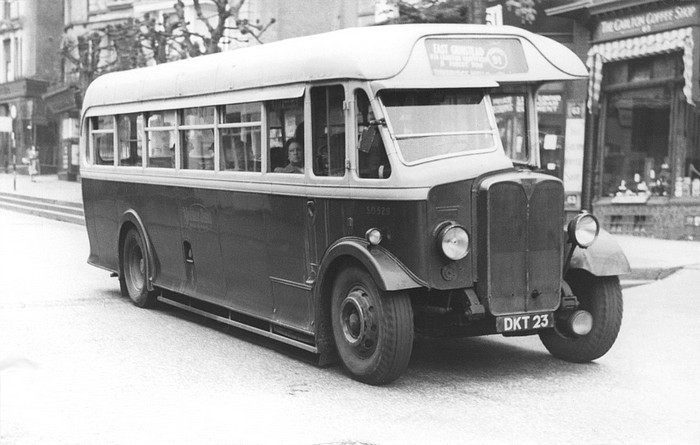
1937 AEC Regal bus 58 (DKT 23) soldiering on into the 1950s, after being renumbered SO529, on
Maidstone and District route 91 from Tunbridge Wells to East Grinstead. Photo: Roy Marshall, by permission of the Bristol Vintage
bus group.
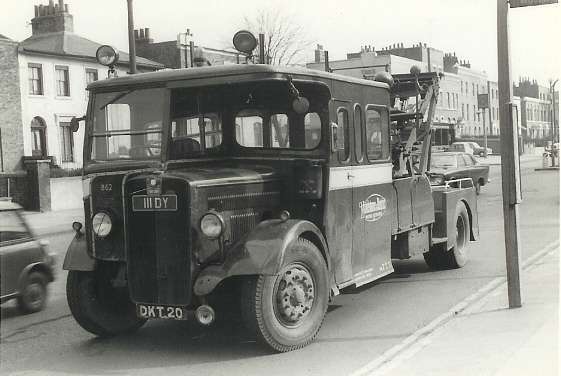
The chassis of no. 55 (later SO526) was converted to a recovery vehicle in 1956 using body parts
from 1931 Titan TD1 no.862, whose fleet number it initially adopted (as seen here), later becoming 917 and then P32. It was
photographed at Maidstone depot on 18 Feb 1968, and still survives in this form. (Photo by kind permission of Peter Esposito, via
Chris Stanley.)
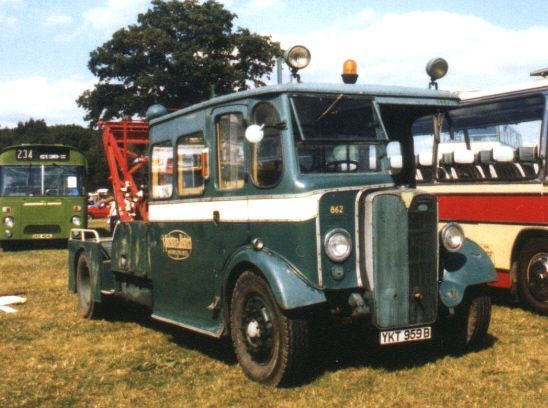
Here is the same vehicle as above (previously DKT 20) at an unknown date and location (Hellingly
Festival of Transport maybe?) wearing its present registration number YKT 959B. Photo by kind permission of Michael Clarke, via
Chris Stanley.
- 53 (DKT 18) c/n O6622261. Harrington B36F. To Royal Navy 6/41 for use as ambulance. Returned 17/3/48. Body rebuilt by Portsmouth Aviation 10/48 and chassis rebuilt by M and D 11/48. Renumbered SO524 in 1950. To Passenger Vehicle Disposals, Dunchurch 10/55, to Reliance, Newbury 6/56.
- 54 (DKT 19) c/n O6622262. Harrington B36F. To Royal Navy 6/41 for use as ambulance. Returned 2/47. Renumbered SO525 in 1950. To B34F in 6/51. To Passenger Vehicle Disposals, Dunchurch 10/55. With Eagre Construction Co., Scunthorpe 9/56.
- 55 (DKT 20) c/n O6622263. Harrington B36F. Used as an ambulance in World War II, and suffered bomb damage. Renumbered SO526 in 1950. Retired in 1956 and became a recovery truck using modified body previously used by 1931 Leyland TD1 bus 862 (KJ 1942). Renumbered 862 11/56. Renumbered 917 8/69. Renumbered P32 1/73. Re-registered YKT 959B in 7/75 (original registration transferred to staff car XUF 210K). Still active 7/77. With Howe, Polegate, Sussex 2001.**SURVIVOR **.
- 56 (DKT 21) c/n O6622264. Harrington B36F. To Royal Navy 6/41 for use as ambulance. Returned 17/3/48. Body rebuilt by Portsmouth Aviation 10/48 and chassis rebuilt by M and D 11/48. Renumbered SO527 in 1950. To Passenger Vehicle Disposals, Dunchurch 10/55, to Eagre Construction (contractor), Scunthorpe 10/55.
- 57 (DKT 22) c/n O6622265. Harrington B36F. To Royal Navy 6/41 for use as ambulance. Returned 31/3/48. Body rebuilt by Portsmouth Aviation 9/48 and chassis rebuilt by M and D 10/48. Renumbered SO528 in 1950. To Passenger Vehicle Disposals, Dunchurch 10/55, to Eagre Construction (contractor), Scunthorpe 8/56, seen at Barnsley 7/60.
- 58 (DKT 23) c/n O6622266. Harrington B36F. Renumbered SO529 in 1950. Broken up 4/55.
- 59 (DKT 24) c/n O6622267. Harrington B36F. Renumbered SO530 in 1950. Modified to Harrington B34F 6/51. Broken up 5/55.
- 60 (DKT 25) c/n O6622268. Harrington B36F. To Royal Navy 6/41 for use as ambulance. Returned 31/3/48. Body rebuilt by Portsmouth Aviation 10/48 and chassis rebuilt by M and D 11/48. Renumbered SO531 in 1950. To Passenger Vehicle Disposals, Dunchurch 10/55, to Reliance, Newbury 6/57. To Press (contractor), Edmonton 11/59.
AEC REGAL BUSES - SO4 to SO35 (Total 32)
Delivered Aug 1946 to May 1947
Chassis: AEC Regal O662/20 (6 cylinder oil engines).
Body: Beadle B36F.
Notes: All were still operating in 1956, but had all gone by the end of 1958, except SO9, 16 and 26.
These three were converted to open top (OB35F) in 1957 for seafront services at Hastings and elsewhere, and were renumbered OR1,
2 and 3. All three survive today.
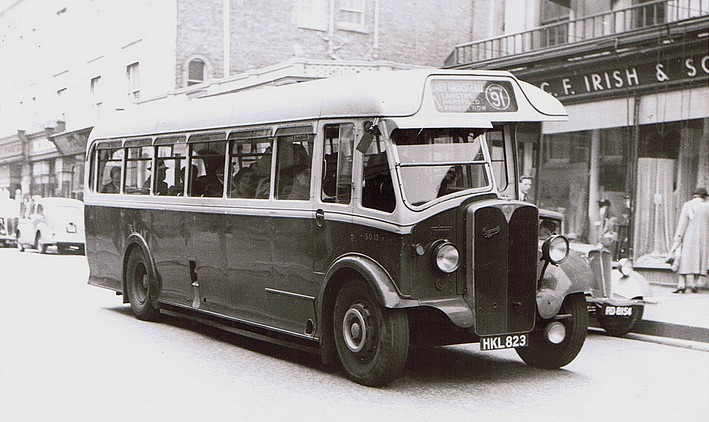
Another AEC Regal bus on route 91 from Tunbridge Wells to East Grinstead (probably seen here in
Tunbridge Wells) is post-war SO13 (HKL 823), showing the more modern styling of its Beadle bodywork. Photo: Roy Marshall, by
permission of the Bristol Vintage bus group.
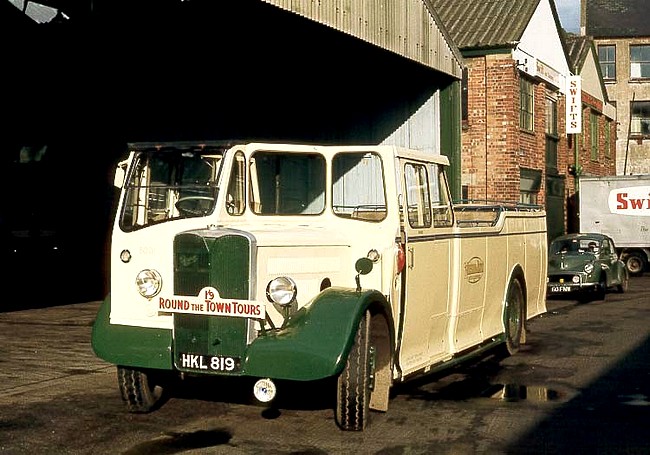
HKL 819 in its rebuilt guise as open-top 8001. Photo taken at Hastings depot by Cliff Essex,
summer 1968.
- SO4 (HKL 814) c/n O6624604, b/n 387, deliv.8/46. To Passenger Vehicle Disposals, Dunchurch 8/57. London Brick Co., Stewartby 6/58 as C5, withdrawn 1966.
- SO5 (HKL 815) c/n O6624605, b/n 392, deliv.11/46. To Passenger Vehicle Disposals, Dunchurch 2/58. With Lovatt (contractor), Wolverhampton 9/59.
- SO6 (HKL 816) c/n O6624606, b/n 388, deliv.8/46. To British Railways (London Midland Region), Derby 10/56 to 10/59 as 847-SO-M.
- SO7 (HKL 817) c/n O6624607, b/n 390, deliv.10/46. To Passenger Vehicle Disposals, Dunchurch 8/57. With Mercury, Boscombe 7/58. St.George's Ambulance Service, Teddington 4/61.
- SO8 (HKL 818) c/n O6624608, b/n 389, deliv.11/46. To Passenger Vehicle Disposals, Dunchurch 8/57. West End Garage, Leamington 8/58. With L. E. A. Coaches (dealer), Coventry in 1960.
- SO9 (HKL 819) c/n O6624609, b/n 391, deliv.11/46. Converted to OB35F in May 1958 and became OR1, and then 8001 in 1968. Withdrawn at end 1970. With E.C.Cooper and Son (dealer), Isfield 4/71, still there 6/72. **SURVIVOR** Paul Baker, St.Neots 2010.
- SO10 (HKL 820) c/n O6624610, b/n 393, deliv.2/47. To British Railways (London Midland Region), Derby 10/57 as 931-SO-M. At Nottingham 3/62.
- SO11 (HKL 821) c/n O6624611, b/n 397, deliv.9/46. To Passenger Vehicle Disposals, Dunchurch 2/58. To Colbro (dealer), Rothwell 2/58 to 2/59. With Lovatt (contractor), Wolverhampton 2/60. Derelict by 1964.
- SO12 (HKL 822) c/n O6624612, b/n 396, deliv.9/46. To Passenger Vehicle Disposals, Dunchurch 8/57. With West End Garage, Leamington in 1958. With L.E.A.Coaches (dealer), Coventry 1/60, with Toogood 2/60 as mobile shop, Coventry, using trade plates 007 DU.
- SO13 (HKL 823) c/n O6624613, b/n 395, deliv.2/47. To Passenger Vehicle Disposals, Dunchurch 2/58. To Colbro (dealer), Rothwell 2/58. With Mercury, Boscombe 7/58, withdrawn 12/61.
- SO14 (HKL 824) c/n O6624614, b/n 394, deliv.8/46. To Passenger Vehicle Disposals, Dunchurch 2/58. To Diesel Engine Exporters (dealer), Rothwell 4/58. Returned to Passenger Vehicle Disposals 8/58 and still with them 1/60.
- SO15 (HKL 825) c/n O6624615, b/n 398, deliv.9/46. To Passenger Vehicle Disposals, Dunchurch 8/57. London Brick Co., Stewartby 6/58 as C6, withdrawn 12/65.
- SO16 (HKL 826) c/n O6624616, b/n 399, deliv.9/46. Converted to OB35F in Nov 1957 and became OR2, and then 8002 in 1968 (Picture here), and to 4002 in 1975. Still in use at Hastings, summer 1972. **SURVIVOR** North East Preservation Trust 2012.
- SO17 (HKL 827) c/n O6624911, b/n 404, deliv.10/46. To Passenger Vehicle Disposals, Dunchurch 2/58. To Colbro (dealer), Rothwell 2/58 to 2/59. With Lovatt (contractor), Wolverhampton 2/60.
- SO18 (HKL 828) c/n O6624912, b/n 403, deliv.10/46. To Passenger Vehicle Disposals, Dunchurch 2/58. To Diesel Engine Exporters (dealer), Rothwell 4/58. Colbro (dealer), Rothwell 11/58. Fleet Car Sales (dealer), Dunchurch 1/60.
- SO19 (HKL 829) c/n O6624913, b/n 405, deliv.10/46. To Passenger Vehicle Disposals, Dunchurch 2/58. Colbro (dealer), Rothwell 2/58 to 2/59. Fleet Car Sales (dealer), Dunchurch 1/60. Fossett (showman), Hampstead Heath 7/60, and at Bexhill 9/66 as mobile food facility for stallholders.
- SO20 (HKL 830) c/n O6624914, b/n 401, deliv.10/46. To Passenger Vehicle Disposals, Dunchurch 8/57. West End Garage, Leamington 1958.
- SO21 (HKL 831) c/n O6624915, b/n 400, deliv.9/46. To Passenger Vehicle Disposals, Dunchurch 8/57. With West End Garage, Leamington 1958.
- SO22 (HKL 832) c/n O6624916, b/n 402, deliv.10/46. To British Railways (London Midland Region) 7/56 to 6/59.
- SO23 (HKL 833) c/n O6624917, b/n 406, deliv.10/46. To Passenger Vehicle Disposals, Dunchurch 7/57. To Dowsett (contractor) 1957. Later to Hoyle (dealer), Wombwell.
- SO24 (HKL 834) c/n O6624918, b/n 430, deliv.2/47. To Passenger Vehicle Disposals, Dunchurch 8/57. With Wilesmith (contractor), Malvern 10/58, still with them 8/66.
- SO25 (HKL 835) c/n O6624919, b/n 431, deliv.3/47. To British Railways (London Midland Region) 7/56 as 894-SO-M, at Windsor. Withdrawn 10/59.
- SO26 (HKL 836) c/n O6624920, b/n 432, deliv.3/47. Converted to OB35F in June 1958 for Hastings seafront services, and became OR3, then 8003 in 1968 and 4003 in 1975. To Hastings and District in mid 1980s as no. 436. **SURVIVOR** London Bus Company 2011.
- SO27 (HKL 837) c/n O6624921, b/n 438, deliv.4/47. To British Railways (London Midland Region) 7/56 as 850-SO-M. Withdrawn 10/59.
- SO28 (HKL 838) c/n O6624922, b/n 434, deliv.4/47. To Passenger Vehicle Disposals, Dunchurch 8/57. To Jones, Aberbeeg 10/57 as no.84. Withdrawn 7/61, derelict at Pontillin 7/62.
- SO29 (HKL 839) c/n O6624923, b/n 435, deliv.4/47. To Passenger Vehicle Disposals, Dunchurch 8/57. To Dowsett (contractor), Uppingham.
- SO30 (HKL 840) c/n O6624924, b/n 433, deliv.3/47. To British Railways (Eastern Region) 7/56 as EAA0101, at Hull 1958.
- SO31 (HKL 841) c/n O6624925, b/n 446, deliv.3/47. To Passenger Vehicle Disposals, Dunchurch 2/58. Mobile caravan, Manchester 11/61.
- SO32 (HKL 842) c/n O6624926, b/n 440, deliv.4/47. To British Railways (London Midland Region) 7/56 as 851-SO-M, at Windsor. Withdrawn 10/60.
- SO33 (HKL 843) c/n O6624927, b/n 437, deliv.3/47. To British Railways (London Midland Region) 7/56 as 852-SO-M. Withdrawn around 1961. Later seen as caravan at Gretna Green. With Bramhope Village Scout Troop 5/65. Jackson (dealer), Bradford 1966.
- SO34 (HKL 844) c/n O6624928, b/n 439, deliv.4/47. To Passenger Vehicle Disposals, Dunchurch 7/57. To Lloyds, Nuneaton 10/57. With Clarke, Newcastle Emlyn 12/58; display van at Royal Counties Show, Salisbury 6/60. With showman, Edinburgh 11/60.
- SO35 (HKL 845) c/n O6624535, b/n 441, deliv.5/47. To Passenger Vehicle Disposals, Dunchurch 2/58. To Colbro (dealer), Dunchurch 2/58. To Service, Bebside 6/58.
AEC REGAL 1 COACHES - CO1 to 31 (Total 31)
Delivered April 1947 to March 1948
Chassis: AEC Regal I (7.7 litre 6-cylinder oil engines).
Body: Harrington C32F.
Notes: All were still operating in 1957, but all had gone by the end of 1959.
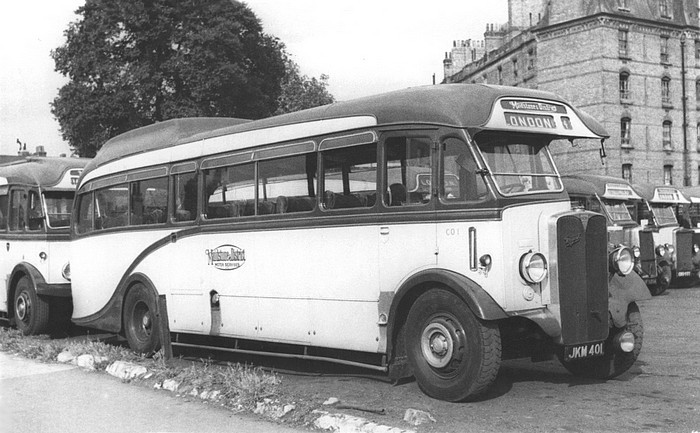
The first vehicle in the fleet to receive a CO (Coach, Oil engine) prefix was CO1 (JKM 401).
There are at least six saloons visible in this picture, including examples from Southdown and East Kent. Most show London as
their destination, so maybe this was a big event. (Photo: Roy Marshall, by permission of the East Pennine transport group,
Huddersfield)
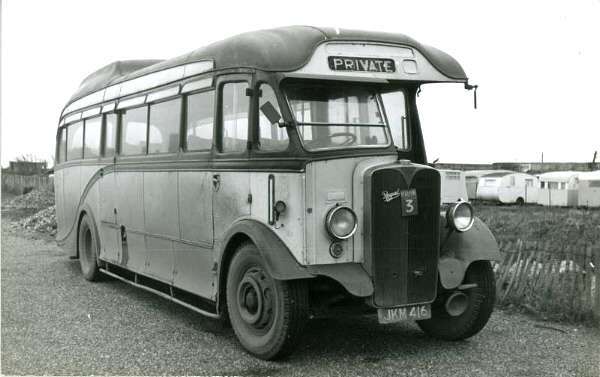
Here is CO16 (JKM 416) after its retirement from M and D service, on the Isle of Sheppey sometime
around 1960, apparently in use to carry construction workers for McAlpine, and presumably on hire from Contract Bus Services.
Picture by kind permission of Trevor Edwards.
- CO1 (JKM 401) - c/n 06625145, b/n 24, deliv.4/47. To Passenger Vehicle Disposals, Dunchurch 2/58. With Contract Bus Services, London W1 in 1959, withdrawn 4/61, with Way (dealer), Cardiff 10/61.
- CO2 (JKM 402) - c/n 06625147, b/n 92, deliv.4/47. To Passenger Vehicle Disposals, Dunchurch 9/56. Sold to Pilcher, Chatham 9/56. To Contract Bus Services 7/60, still with them 1961.
- CO3 (JKM 403) - c/n 06625149, b/n 101, deliv.5/47. To Passenger Vehicle Disposals, Dunchurch 9/56. To Lloyd, Nuneaton 11/56. Returned to Passenger Vehicle Disposals 8/58. With Contract Bus Services 7/60 to 4/61.
- CO4 (JKM 404) - c/n 06625151, b/n 113, deliv.5/47. To Passenger Vehicle Disposals, Dunchurch 9/56. To Lloyd, Nuneaton 11/56. With Webster, Pattishall 5/60. With contractor at Watford 7/60.
- CO5 (JKM 405) - c/n 06625146, b/n 118, deliv.5/47. To Passenger Vehicle Disposals, Dunchurch 9/56. Sold 1956 to Shurrocks, Brill; still with them 8/57. To McLennan (dealer), Spittalfield as car transporter by 4/63.
- CO6 (JKM 406) - c/n 06625126, b/n 122, deliv.6/47. To Passenger Vehicle Disposals, Dunchurch 9/56. With Duncan, Motherwell in 1959. Sold 10/59 to Tiger Coaches (dealer), Salsburgh.
- CO7 (JKM 407) - c/n 06625128, b/n 124, deliv.6/47. To Passenger Vehicle Disposals, Dunchurch 9/56. With Edmunds, Rassau in 1957, still with them 1959. Derelict by 1962.
- CO8 (JKM 408) - c/n 06625130, b/n 130, deliv.6/47. To Passenger Vehicle Disposals, Dunchurch 9/56. To Lloyd, Nuneaton 11/56. To Fleet Car Sales, Dunchurch 1/60, to Jones, Crymnach 2/60.
- CO9 (JKM 409) - c/n 06625135, b/n 133, deliv.6/47. To Passenger Vehicle Disposals, Dunchurch 9/56. With Cunningham, Paisley 6/57 as no.20. With showman 1960.
- CO10 (JKM 410) - c/n 06625137, b/n 135, deliv.7/47. To Passenger Vehicle Disposals, Dunchurch 9/56. To Lloyd, Nuneaton 10/56. Returned to Passenger Vehicle Disposals 8/58, to Contract Bus Services, Llanwern 9/58 to 4/61.
- CO11 (JKM 411) - c/n 06625155, b/n 154, deliv.7/47. To Passenger Vehicle Disposals, Dunchurch 9/56. To Lloyd, Nuneaton 10/56. To Fleet Car Sales, Dunchurch 1/60.
- CO12 (JKM 412) - c/n 06625124, b/n 157, deliv.7/47. To Passenger Vehicle Disposals, Dunchurch 2/58. To Contract Bus Services, London 7/58, withdrawn 4/61. Bryn Motor Services, Pontllanfraith 1962.
- CO13 (JKM 413) - c/n 06625131, b/n 165, deliv.8/47. To Passenger Vehicle Disposals, Dunchurch 2/58. To Contract Bus Services, London 4/58, withdrawn 4/61.
- CO14 (JKM 414) - c/n 06625152, b/n 173, deliv.8/47. To Passenger Vehicle Disposals, Dunchurch 2/58. To Contract Bus Services, London 7/58 (in use at Gillingham 1958). Withdrawn 4/62.
- CO15 (JKM 415) - c/n 06625125, b/n 178, deliv.9/47. To Passenger Vehicle Disposals, Dunchurch 2/58. To Contract Bus Services, London 7/60, still in use 1961.
- CO16 (JKM 416) - c/n 06625148, b/n 189, deliv.10/47. To Passenger Vehicle Disposals, Dunchurch 2/58. To Contract Bus Services, London 7/58, still in use 1961. With Way (dealer), Cardiff 9/62.
- CO17 (JKM 417) - c/n 06625144, b/n 192, deliv.10/47. To Passenger Vehicle Disposals, Dunchurch 2/58. To Contract Bus Services, London 7/60, still in use 4/62.
- CO18 (JKM 418) - c/n 06625156, b/n 200, deliv.10/47. To Passenger Vehicle Disposals, Dunchurch 2/58. With Contract Bus Services, London W1 in 1959, withdrawn 4/61, with Way (dealer), Cardiff 10/61.
- CO19 (JKM 419) - c/n 06625154, b/n 201, deliv.11/47. To Passenger Vehicle Disposals, Dunchurch 2/58. With Contract Bus Services, London 5/58, withdrawn 9/59. With Way (dealer), Cardiff 3/62.
- CO20 (JKM 420) - c/n 06625153, b/n 209, deliv.11/47. To Passenger Vehicle Disposals, Dunchurch 2/58. To Contract Bus Services, London 7/60, still in use 1961. With Fleur-de-Lis by 1/62.
- CO21 (JKM 421) - c/n 06625150, b/n 215, deliv.12/47. To Passenger Vehicle Disposals, Dunchurch 2/58. To Contract Bus Services, London 7/60, still in use 1961. With Way (dealer), Cardiff 9/62.
- CO22 (JKM 422) - c/n 06625157, b/n 221, deliv.12/47. To Passenger Vehicle Disposals, Dunchurch 2/58. To Contract Bus Services, London 7/60, still in use 1961.
- CO23 (JKM 423) - c/n 06625159, b/n 227, deliv.12/47. To British Transport Commission (London Midland Region) 8/58. To British Railways (Western Region), Wolverhampton 3/59. With Whitworth-Gloster, Coventry (Baginton) 3/62.
- CO24 (JKM 424) - c/n 06625163, b/n 236, deliv.1/48. Sold 8/58 to British Railways (London Midland Region). Seen at Pont-y-Pant 8/60. At yard of Passenger Vehicle Disposals, Dunchurch 7/61. With British Railways (London Midland Region) 12/62 as 1019-SO-M.
- CO25 (JKM 425) - c/n 06625160, b/n 239, deliv.1/48. Sold 8/58 to British Railways (London Midland Region) as 1020-SO-M, based Birmingham 1959-61. With contractor, Hatherton 6/62. With contractor Coventry 6/63.
- CO26 (JKM 426) - c/n 06625167, b/n 244, deliv.1/48. Sold 8/58 to British Railways (London Midland Region) as 1021-SO-M. Based Manchester 3/64.
- CO27 (JKM 427) - c/n 06625164, b/n 253, deliv.1/48. Sold 9/58 to British Railways (Eastern Region) as EAA0302E, based Long Melford. Still with them 5/65.
- CO28 (JKM 428) - c/n 06625158, b/n 264, deliv.2/48. To Fleet Car Sales (dealer), Dunchurch 6/59. With D.J.Jones, Crymnych 1961. Sold for scrap 4/64.
- CO29 (JKM 429) - c/n 06625161, b/n 274, deliv.2/48. To Fleet Car Sales (dealer), Dunchurch 6/59. To Churchbridge, Cannock by 10/59 as their no.9. Scrapped 10/61.
- CO30 (JKM 430) - c/n 06625166, b/n 275, deliv.2/48. To Fleet Car Sales (dealer), Dunchurch 6/59. To Douglas, Byfield 4/60. To Rhodes (dealer), Nottingham 6/60. To Longhursts Portsdown Coaches, Broadcut, Hants 7/60. To Fisher, Gosport as mobile shop 7/61; still with them 1964.
- CO31 (JKM 431) - c/n 06621568, b/n 279, deliv.3/48. To Fleet Car Sales (dealer), Dunchurch 6/59. To Baxter, Birmingham 7/59 as no.22C. Withdrawn 11/59. To Fleet Car Sales, Dunchurch 1/60. With Contract Bus Services 7/60 to 3/62.
AEC REGAL COACHES - CO32 to 61 (Total 30)
Delivered March 1948 to January 1949
Chassis: AEC Regal (6 cylinder oil engines).
Body: Beadle C32F.
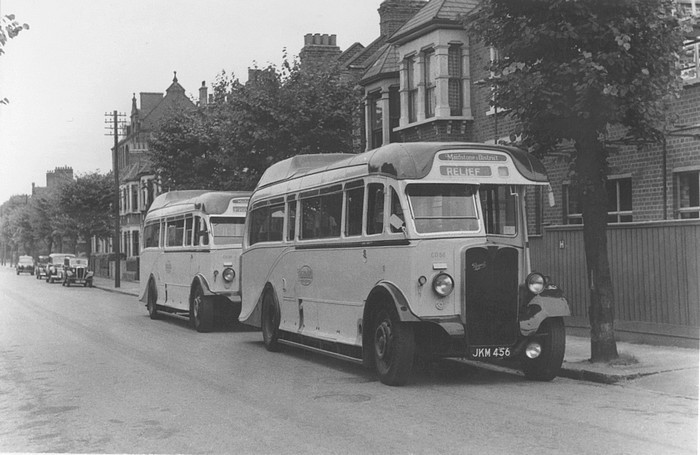
The style of coachwork on CO56 (JKM 456) borrows much from pre-war designs and could be mistaken
for a Harrington product of the previous decade. However the two panoramic windows down each side are distinctive. CO49 from the
same batch is parked behind, in this 1950s view. (Photo: thanks to the M. and D. and East Kent bus club).
Notes: All still operating in 1958, but all had gone by the end of the 1961 season (CO58 and 59
were the last to be withdrawn).
- CO32 (JKM 432) c/n O6625127, b/n 482, deliv.3/48. To Fleet Car Sales (dealer), Dunchurch 6/59. To Jones, Crymmych 10/59. Derelict by 1964.
- CO33 (JKM 433) c/n O6625129, b/n 483, deliv.3/48. Based at Gillingham 1959. To Fleet Car Sales (dealer), Dunchurch 6/59. Sold to C.Davies, Pontlottyn 8/59. Returned to Fleet Car Sales 1/60.
- CO34 (JKM 434) c/n O6625132, b/n 484, deliv.3/48. To Fleet Car Sales (dealer), Dunchurch 6/59. With Ives, Derby 8/60, but withdrawn 1964.
- CO35 (JKM 435) c/n O6625133, b/n 485, deliv.3/48. To Fleet Car Sales (dealer), Dunchurch 6/59. To Wimpey (contractor), Silverhill 7/59. At General Car Auctions (dealer) 5/62.
- CO36 (JKM 436) c/n O6625134, b/n 486, deliv.3/48. To Fleet Car Sales (dealer), Dunchurch 6/59. Sold to Chinn, Hockley Heath 7/59, then to Green, Brierley Hill 11/59, to Passenger Vehicle Disposals, Dunchurch 1/61.
- CO37 (JKM 437) c/n O6625136, b/n 487, deliv.3/48. To Fleet Car Sales (dealer), Dunchurch 6/59. To Wimpey (contractors), Southampton 8/59 as no. 129. To General Car Auctions 5/62.
- CO38 (JKM 438) c/n O6625138, b/n 488, deliv.6/48. To Fleet Car Sales (dealer), Dunchurch 6/59. Sold to C. Davies, Pontlottyn 8/59. With Contract Bus Services 7/60 to 4/61. With R. Fossett (showman) by 1963.
- CO39 (JKM 439) c/n O6625139, b/n 489, deliv.6/48. To Fleet Car Sales (dealer), Dunchurch 5/60. With Contract Bus Services 4/61. To Way (dealer), Cardiff 9/62.
- CO40 (JKM 440) c/n O6625140, b/n 490, deliv.6/48. To Fleet Car Sales (dealer), Dunchurch 5/60. With Contract Bus Services 1/61 to 4/61. To Jones (dealer), Cardiff Docks. Still there but derelict 1964.
- CO41 (JKM 441) c/n O6625141, b/n 491, deliv.6/48. To Fleet Car Sales (dealer), Dunchurch 5/60. With John Hunt (builders), Gosport 8/60 to 4/61.
- CO42 (JKM 442) c/n O6625142, b/n 492, deliv.6/48. To Fleet Car Sales (dealer), Dunchurch 6/60. With Contract Bus Services 6/60 to 8/62.
- CO43 (JKM 443) c/n O6625143, b/n 493, deliv.7/48. To Fleet Car Sales (dealer), Dunchurch 6/60. With contractor, Leicester 7/60. With Contract Bus Services, Scunthorpe 4/61. Way (dealer), Cardiff 9/62.
- CO44 (JKM 444) c/n O6625162, b/n 494, deliv.7/48. To Fleet Car Sales (dealer), Dunchurch 5/60. With Contract Bus Services 7/60 to 4/61. With Way (dealer), Cardiff 9/62.
- CO45 (JKM 445) c/n O6625165, b/n 495, deliv.8/48. To Fleet Car Sales (dealer), Dunchurch 5/60. With contractor, Leicester 7/60. Contract Bus Services, Scunthorpe 4/61. With Way (dealer), Cardiff 9/62.
- CO46 (JKM 446) c/n O6625169, b/n 496, deliv.11/48. To Fleet Car Sales (dealer), Dunchurch 10/60. With Leslie (contractor), London N8 by 8/61 and still with them 5/62.
- CO47 (JKM 447) c/n O6625170, b/n 497, deliv.11/48. To Fleet Car Sales (dealer), Dunchurch 10/60. With contractor, Sunderland by 6/61, still with them 5/62.
- CO48 (JKM 448) c/n O6625171, b/n 498, deliv.11/48. To Fleet Car Sales (dealer), Dunchurch 10/60. With contractor, Shepherds Bush 11/60. Cambell and Isherwood (contractor), Llanwern 4/61.
- CO49 (JKM 449) c/n O6625172, b/n 499, deliv.11/48. To Fleet Car Sales (dealer), Dunchurch 10/60. With Contract Bus Services, Newport, Mon. 12/60. With Ress and Kirby (contractor), Swansea 4/61.
- CO50 (JKM 450) c/n O6625173, b/n 500, deliv.11/48. To Fleet Car Sales (dealer), Dunchurch 10/60. With Rockbeare Quarries, Exeter 1962 for staff transport.
- CO51 (JKM 451) c/n O6625174, b/n 501, deliv.11/48. To Fleet Car Sales (dealer), Dunchurch 10/60. Sold 10/61 to Crake, Darlington. Scrapped, Coldwell 2/63.
- CO52 (JKM 452) c/n O6625175, b/n 502, deliv.12/48. To Fleet Car Sales (dealer), Dunchurch 12/59. With Hanford, Barton 3/60. Scrapped 1/65.
- CO53 (JKM 453) c/n O6625176, b/n 503, deliv.12/48. To Fleet Car Sales (dealer), Dunchurch 12/59. With Contract Bus Services 7/60 to 4/61, then sold to showman, Doncaster.
- CO54 (JKM 454) c/n O6625177, b/n 504, deliv.12/48. To Fleet Car Sales (dealer), Dunchurch 12/59. With Contract Bus Services 4/61, then to Way (dealer), Cardiff 4/62.
- CO55 (JKM 455) c/n O6625178, b/n 505, deliv.12/48. To Fleet Car Sales (dealer), Dunchurch 12/59. With Contract Bus Services 7/60 to 4/61.
- CO56 (JKM 456) c/n O6625179, b/n 506, deliv.12/48. To Fleet Car Sales (dealer), Dunchurch 12/59. To G. and G., Leamington 1/60 to 1/61. With Grainge, Westbury 3/61, withdrawn 1963.
- CO57 (JKM 457) c/n O6625180, b/n 507, deliv.12/48. To Fleet Car Sales (dealer), Dunchurch 12/59. With Contract Bus Services, Llanwern 7/60 to 8/62, sold to Way (dealer), Cardiff.
- CO58 (JKM 458) c/n O6625181, b/n 508, del. 1/49. Renumbered C58 in 1961. To Fleet Car Sales, Dunchurch 10/61. With Mitchell (contractor), Beauly, Inverness 6/62. With F.Cowley (dealer), Dunchurch 10/65.
- CO59 (JKM 459) c/n O6625182, b/n 509, del. 1/49. Renumbered C59 in 1961. To Fleet Car Sales, Dunchurch 10/61.
- CO60 (JKM 460) c/n O6625183, b/n 510, del. 1/49. Renumbered C60 in 1961. To Fleet Car Sales, Dunchurch 8/61. With Whitworth-Gloster, Coventry (Baginton) 9/61 for staff transport. To Hawker-Siddeley Aviation 4/64.
- CO61 (JKM 461) c/n O6625184, b/n 511, del. 1/49. Renumbered C61 in 1961. To Fleet Car Sales, Dunchurch 8/61. With Whitworth-Gloster, Coventry (Baginton) 3/62 for staff transport. To Hawker-Siddeley Aviation 5/64. To L.M.Shand (contractor), Envil Common 7/64.
AEC REGAL III COACHES - CO62 to 116 (Total 45)
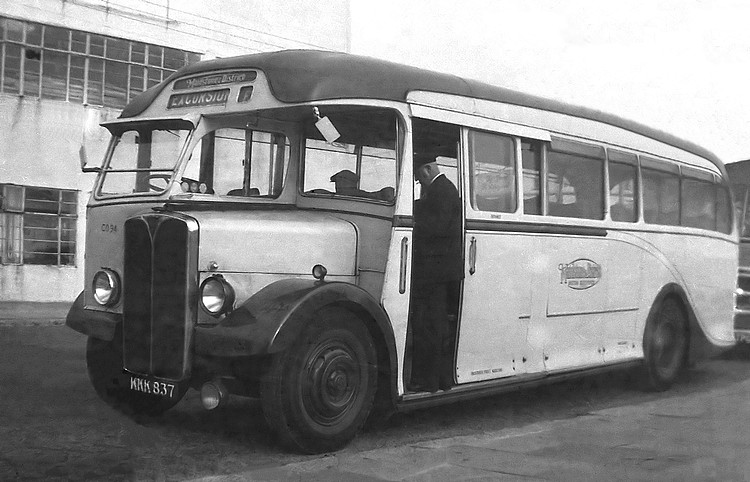
Seen at Littlehampton on an excursion in its final year of operation (1961) is 1948 Regal coach
CO94 (KKK 837). Sadly, none of them survive. (Photo: Dick Gilbert)
Delivered 1948-49
Chassis: CO62-72 were AEC Regal III O682, while CO73-116 were AEC Regal III 6821A. Actually there
was no difference between these models, AEC had merely dropped the O prefix (for oil engine) during 1948. All had 7.7 litre 6-
cylinder oil engines.
Body: CO62-84 were fitted with 1936 Harrington C31F bodies transferred in 1948/49 (after overhaul
by Portsmouth Aviation) from 1929 AEC Reliances, originally with Timpsons, Hastings and numbered between 151-176 (DY 5681-5723).
The remainder (CO85-116) had Harrington C32F bodies from new, except that CO97 and CO113-116 had
Harrington FC32F full-fronted bodies.
The running gear from CO62-84 was used in the construction of Beadle rebuilds CO354-376 in 1955-56
(see below).
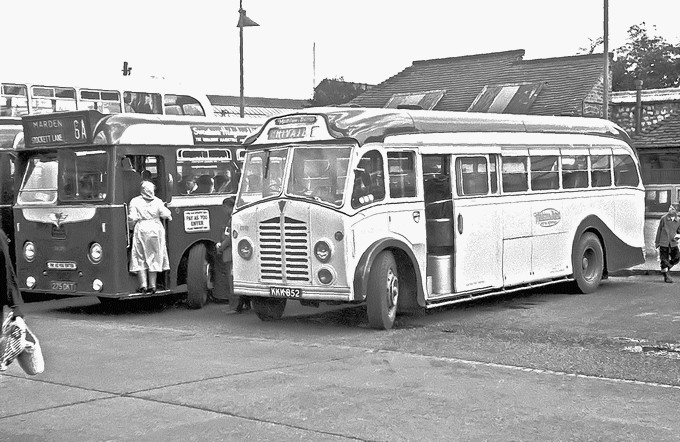
KKK 852 (CO113) was one of five delivered with full-fronted bodywork by Harrington. This photo,
by kind permission of Ray Deacon, was taken in Stone Street, Maidstone in 1961.
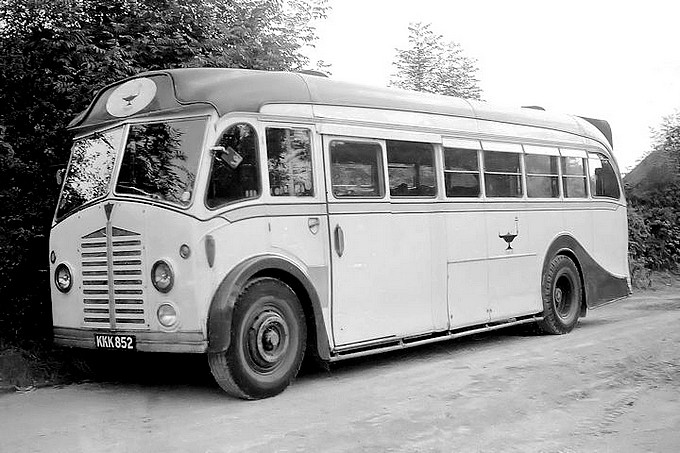
KKK 852 again, seen here towards the end of 1969 in a yard beside a pub in Wivelsfield Green,
Sussex while in use by the TOC-H organisation. Photo by kind permission of Ray Deacon.
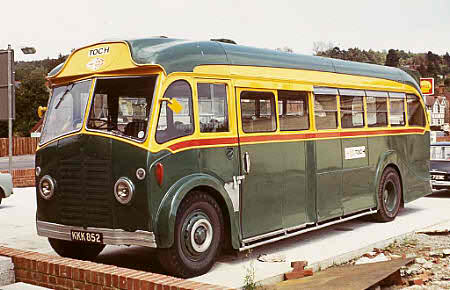
Here is KKK 852 again, this time seen in May 1972 in Hythe, Kent, still in use by TOC-H. Photo
thanks to Cliff Essex.
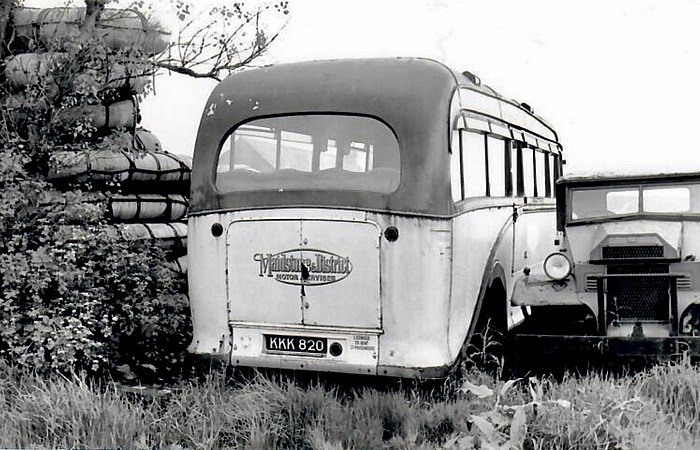
Leon Coast kindly sent me this picture in February 2022. It came from the Roy Simmons collection
(although not taken by him) and is reproduced with his permission. It shows CO81 (KKK 820) in its final resting place behind the
East Kent garage in Rye. On the right is a Canadian Military Pattern (CMP) truck from World War II, with what looks to be a pile
of dinghies on the left! How they turned up behind an East Kent depot is a bit of a mystery.
- CO62 (KKK 801) c/n O682061, del 3/48. Body new 1936, from ex-Timpsons Reliance 172 (DY 5719). Components used to create CO359 12/55.
- CO63 (KKK 802) c/n O682062, del 4/49. Body new 1936, from ex-Timpsons Reliance 171 (DY 5717). Components used to create CO360 1/56.
- CO64 (KKK 803) c/n O682063, del 6/48. Body new 1936, from ex-Timpsons Reliance 154 (DY 5684). Components used to create CO361 12/55.
- CO65 (KKK 804) c/n O682064, del 3/48. Body new 1936, from ex-Timpsons Reliance 169 (DY 5715). Components used to create CO362 12/55.
- CO66 (KKK 805) c/n O682065, del 6/49. Body new 1936, from ex-Timpsons Reliance 166 (DY 5712). Components used to create CO365 1/56.
- CO67 (KKK 806) c/n O682066, del 3/48. Body new 1936, from ex-Timpsons Reliance 170 (DY 5716). Components used to create CO363 1/56.
- CO68 (KKK 807) c/n O682067, del 5/48. Body new 1936, from ex-Timpsons Reliance 165 (DY 5695). Components used to create CO364 1/56.
- CO69 (KKK 808) c/n O682068, del 6/48. Body new 1936, from ex-Timpsons Reliance 174 (DY 5721). Components used to create CO373 4/56.
- CO70 (KKK 809) c/n O682069, del 5/48. Body new 1936, from ex-Timpsons Reliance 155 (DY 5685). Components used to create CO374 4/56.
- CO71 (KKK 810) c/n O682070, del 5/48. Body new 1936, from ex-Timpsons Reliance 167 (DY 5713). Components used to create CO375 3/56.
- CO72 (KKK 811) c/n O682071, del 5/48. Body new 1936, from ex-Timpsons Reliance 176 (DY 5723). Components used to create CO376 4/56.
- CO73 (KKK 812) c/n 6821A058, del. 4/49. Body new 1936, from ex-Timpsons Reliance 156 (DY 5686). Components used to create CO366 2/56.
- CO74 (KKK 813) c/n 6821A056, del. 4/49. Body new 1936, from ex-Timpsons Reliance 152 (DY 5682). Components used to create CO367 2/56.
- CO75 (KKK 814) c/n 6821A060, del. 4/49. Body new 1936, from ex-Timpsons Reliance 164 (DY 5694). Components used to create CO357 12/55.
- CO76 (KKK 815) c/n 6821A054, del. 4/49. Body new 1936, from ex-Timpsons Reliance 151 (DY 5681). Components used to create CO358 12/55.
- CO77 (KKK 816) c/n 6821A081, del. 4/49. Body new 1936, from ex-Timpsons Reliance 157 (DY 5687). Components used to create CO355 12/55.
- CO78 (KKK 817) c/n 6821A055, del. 4/49. Body new 1936, from ex-Timpsons Reliance 153 (DY 5683). Components used to create CO368 2/56.
- CO79 (KKK 818) c/n 6821A057, del. 4/49. Body new 1936, from ex-Timpsons Reliance 159 (DY 5689). Components used to create CO372 5/56.
- CO80 (KKK 819) c/n 6821A082, del. 4/49. Body new 1936, from ex-Timpsons Reliance 175 (DY 5722). Components used to create CO369 2/56.
- CO81 (KKK 820) c/n 6821A083, del. 5/49. Body new 1936, from ex-Timpsons Reliance 164 (DY 5694). Components used to create CO354 12/55. Original body to Mr.Phillips, Rye 9/55, then to Mr.Browne, Pevensey, used as a store at rear of East Kent's Rye depot until 7/61.
- CO82 (KKK 821) c/n 6821A059, del. 5/49. Body new 1936, from ex-Timpsons Reliance 168 (DY 5714). Components used to create CO370 2/56.
- CO83 (KKK 822) c/n 6821A053, del. 6/49. Body new 1936, from ex-Timpsons Reliance 158 (DY 5688). Components used to create CO356 12/55.
- CO84 (KKK 823) c/n 6821A052, del. 6/49. Body new 1936, from ex-Timpsons Reliance 173 (DY 5720).Components used to create CO371 3/56.
- CO85 (KKK 824) c/n 6821A029, del. 3/48. b/n 304. To Fleet Car Sales (dealer), Dunchurch 6/59, sold to Wimpey (contractor). To Lansdowne, Leytonstone 1962.
- CO86 (KKK 825) c/n 6821A031, del. 3/48. b/n 312. To Fleet Car Sales (dealer), Dunchurch 6/59.
- CO87 (KKK 826) c/n 6821A032, del. 5/48. b/n 328. To Fleet Car Sales (dealer), Dunchurch 6/59. Sold to C.Davies, Pontlottyn 1959.
- CO88 (KKK 827) c/n 6821A034, del. 6/48. b/n 338. To Fleet Car Sales (dealer), Dunchurch 10/60. Sold 1960 to Cosy, Meadowfield.
- CO89 (KKK 828) c/n 6821A035, del. 6/48. b/n 350. Renumbered C89 in 1961. To Fleet Car Sales, Dunchurch 10/61. To Braybrooke, Swaffham 1/62, withdrawn 1965.
- CO90 (KKK 829) c/n 6821A030, del. 7/48. b/n 354. Renumbered C90 in 1961. To Fleet Car Sales, Dunchurch 10/61. To Pilcher, Chatham 12/61, withdrawn 11/63.
- CO91 (KKK 830) c/n 6821A033, del. 7/48. b/n 375. Renumbered C91 in 1961. To Fleet Car Sales, Dunchurch 10/61. To Pilcher, Chatham 12/61, scrapped 3/64.
- CO92 (KKK 831) c/n 6821A036, del. 8/48. b/n 387. Renumbered C92 in 1961. To Fleet Car Sales, Dunchurch 10/61. To Braybrooke, Swaffham 1/62, withdrawn 1/68. With Furborough (dealer), Leicester 9/68.
- CO93 (KKK 832) c/n 6821A039, del. 9/48. b/n 397. Renumbered C93 in 1961. To Fleet Car Sales, Dunchurch 10/61. To Costain (contractor), Middlesex 12/61 until at least 3/64.
- CO94 (KKK 837) c/n 6821A077, del. 11/48. b/n 409. Renumbered C94 in 1961. To Fleet Car Sales, Dunchurch 8/61. To Whitworth-Gloster, Coventry (Baginton) as staff bus 11/61. Derelict with Aston (dealer), Marton 10/65.
- CO95 (KKK 834) c/n 6821A038, del. 11/48. b/n 410. Renumbered C95 in 1961. To Fleet Car Sales, Dunchurch 9/61. With Whitworth-Gloster, Coventry 1962 for staff transport.
- CO96 (KKK 835) c/n 6821A041, del. 11/48. b/n 423. Renumbered C96 in 1961. To Fleet Car Sales, Dunchurch 9/61. To Braybrooke, Swaffham 9/61, withdrawn 9/67 and scrapped at Mendlesham 1969.
- CO97 (KKK 836) c/n 6821A042, del. 4/49. Full-front body no.507. Renumbered C97 in 1961. To Fleet Car Sales, Dunchurch 8/61. To J.D.W., Ipswich 12/61 as no.27. Scrapped by a dealer 8/67.
- CO98 (KKK 833) c/n 6821A040, del. 12/48. b/n 428. Renumbered C98 in 1961. To Fleet Car Sales, Dunchurch 9/61. To Braybrooke, Swaffham 9/61, withdrawn 10/68 and scrapped at Mendlesham 1969.
- CO99 (KKK 838) c/n 6821A075, b/n 434, del. 1/49. Renumbered C99 in 1961. To Fleet Car Sales, Dunchurch 10/61. Sold to Charlton-on-Otmoor Services (Holder), Oxford 11/61. Withdrawn 7/67 and in dealer's yard at Amblecote.
- CO100 (KKK 839) c/n 6821A079, b/n 438, del. 1/49. Renumbered C100 in 1961. To Fleet Car Sales, Dunchurch 9/61. To Braybrooke, Swaffham 9/61, withdrawn 3/68, scrapped at Mendlesham 1969.
- CO101 (KKK 840) c/n 6821A074, b/n 449, del. 1/49. Renumbered C101 in 1961. To Fleet Car Sales, Dunchurch 8/61. To Braybrooke, Swaffham 8/61. Scrapped at Mendlesham by 12/69.
- CO102 (KKK 841) c/n 6821A076, b/n 454, del. 1/49. Renumbered C102 in 1961. To Fleet Car Sales, Dunchurch 8/61. To Braybrooke, Swaffham 8/61. To Collins, Weeley Heath 1963, still active 8/69.
- CO103 (KKK 842) c/n 6821A078, b/n 458, del. 1/49. Renumbered C103 in 1961. To Fleet Car Sales, Dunchurch 10/61. With Aubrey Long (contractor), Torpoint 1962. Still with them 8/65.
- CO104 (KKK 843) c/n 6821A080, b/n 463, del. 1/49. Renumbered C104 in 1961. To Fleet Car Sales, Dunchurch 10/61. To Crouch (contractor), Eye.
- CO105 (KKK 844) c/n 6821A037, b/n 469, del. 4/49. Renumbered C105 in 1961. To Fleet Car Sales, Dunchurch 10/62. With contractor, Newbury 10/63. With Shepherd Hill (contractor), Chesterfield 4/66, but derelict by 8/66.
- CO106 (KKK 845) c/n 6821A072, b/n 475, del. 4/49. Renumbered C106 in 1961. To Fleet Car Sales, Dunchurch 10/62. With contractor, Oxford 8/63 and 2/65. With Shepherd Hill (contractor), Chesterfield 4/66, but derelict by 8/66.
- CO107 (KKK 846) c/n 6821A073, b/n 488, del. 4/49. Renumbered C107 in 1961. To Fleet Car Sales, Dunchurch 11/62. Returned to M and D 11/62 and sold to Transport (Passenger Equipments) Ltd. (dealer), Macclesfield 3/63. With contractor, Farmoor, Oxon 6/63. With Hoskin, Blackwood, Mon. 9/63. Williams, Llantwit Major 6/65, withdrawn 9/65.
- CO108 (KKK 847) c/n 6821A043, b/n 632, del. 11/49. Renumbered C108 in 1961. To Transport (Passenger Equipments) Ltd. (dealer), Macclesfield 1/65.
- CO109 (KKK 848) c/n 6821A044, b/n 636, del. 11/49. Renumbered C109 in 1961. To Fleet Car Sales, Dunchurch 11/62. Returned to M and D 11/62 and sold to Transport (Passenger Equipments) Ltd. (dealer), Macclesfield 3/63. With W.J.Hall, Trelyn 1963.
- CO110 (KKK 849) c/n 6821A045, b/n 642, del. 11/49. Renumbered C110 in 1961. To Transport (Passenger Equipments) Ltd. (dealer), Macclesfield 1/65.
- CO111 (KKK 850) c/n 6821A046, b/n 648, del. 12/49. Renumbered C111 in 1961. To Transport (Passenger Equipments) Ltd. (dealer), Macclesfield 1/65. With Chivers (contractor), Devizes 4/65 number L641. Still with them 3/67.
- CO112 (KKK 851) c/n 6821A047, b/n 661, del. 12/49. Renumbered C112 in 1961. To Transport (Passenger Equipments) Ltd. (dealer), Macclesfield 12/64.
- CO113 (KKK 852) c/n 6821A048, del. 10/49. Full-front body no.617. Renumbered C113 in 1961. Donated to Tunbridge Wells Toc-H organisation (Jubilee Committee) 1/65, modified for invalid transport. Seen working for TOC-H in Wivelsfield Green, Sussex in 1969 and Hythe, Kent in 1972. With Toc-H Croydon by 8/74 and still with them in 1977.
- CO114 (KKK 853) c/n 6821A049, del. 10/49. Full-front body no.623. Renumbered C114 in 1961. To Fleet Car Sales, Dunchurch 9/62. W.J.Hall, Trelyn 7/63, withdrawn 5/68.
- CO115 (KKK 854) c/n 6821A051, del. 11/49. Full-front body no.627. Renumbered C115 in 1961. To Fleet Car Sales, Dunchurch 8/62. To Tilley, Sandridge, St.Albans 8/62. To LCM (dealer) 9/63.
- CO116 (KKK 855) c/n 6821A050, del. 11/49. Full-front body no.631. Renumbered C116 in 1961. To Transport (Passenger Equipments) Ltd. (dealer), Macclesfield 12/64. With Chivers (contractor), Devizes from 1964 to 1967 numbered L633.
AEC REGAL COACHES - CO117 to 122 (Total 6)
Built 1946-52
Chassis: Various AEC Regal models - see list.
Body: Various bodies - see list.
Notes: All acquired from the fleet of Skinner's Coaches, St.Leonards-on-Sea on 15 Aug 1953, painted
blue and retaining the "Skinners" fleetname.
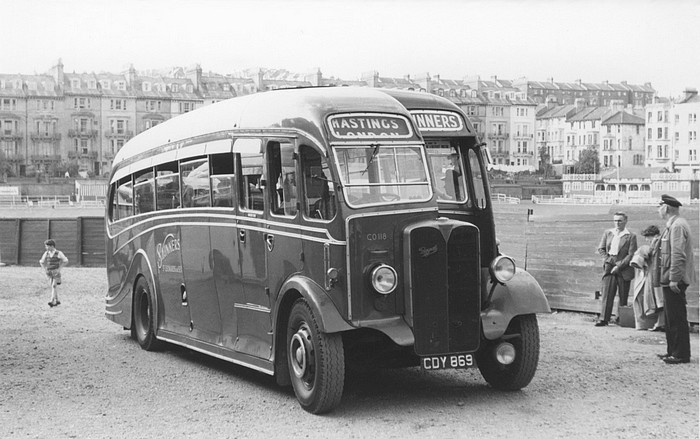
CDY 869 was bought by Skinners in 1947, joining the Maidstone and District fleet in 1953 as CO118,
while keeping its Skinners livery. It is seen here at Hastings Coach Station. Photo: by kind permission of the M. and D. and East
Kent bus club.
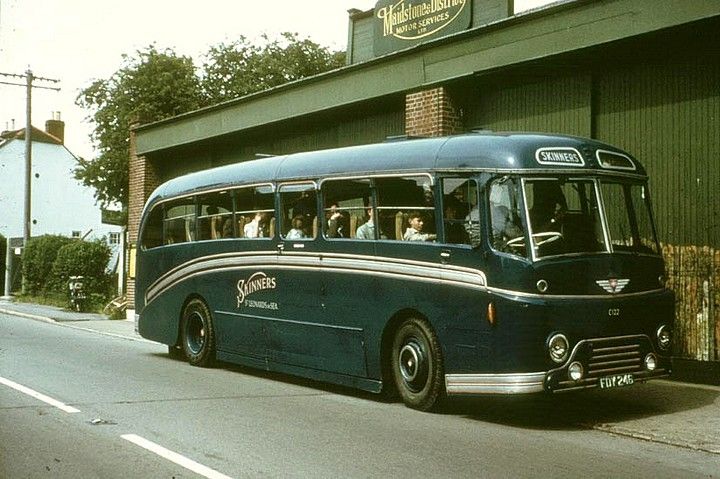
An unusual one-off in the mixed Skinners fleet was this 1952 Regal IV with Gurney-Nutting body,
CO122 (FDY 246) - later renumbered C122. It was to become Maidstone and District's only underfloor AEC Regal but, like the rest
of the Skinners vehicles, retained its original blue livery and titles. The picture shows the coach outside the old Battle garage,
which was used as a store, on an M and D and East Kent bus club tour in early summer 1964 or 1965. Thanks to Cliff Essex for the
photo.
- CO117 (CDY 442) AEC Regal, c/n O6624762, new 10/46. Harrington C32F with sliding roof, b/n 12. Had been Skinner's no. 29. To Fleet Car Sales, Dunchurch 10/60. To Reliance (H.Wilson), Stainforth 11/60. To Swift (dealer), Barnsley 7/63 and scrapped.
- CO118 (CDY 869) AEC Regal, c/n O6625637, new 8/47. Harrington C32F, b/n 147. Had been Skinner's no. 30. To Fleet Car Sales, Dunchurch 10/60. To Reliance (H.Wilson), Stainforth 11/60. Withdrawn 9/64 and became a store.
- CO119 (DDY 69) AEC Regal, c/n O6625636, new 3/48. Harrington C33F, b/n 273. Had been Skinner's no. 31. To Fleet Car Sales, Dunchurch 10/61. JH Constructors (contractor), Aylesford 11/61. Still with them 5/65.
- CO120 (DDY 752) AEC Regal III, c/n 6821A177, new 7/49. Harrington C33F, b/n 586. Had been Skinner's no. 33. To Fleet Car Sales, Dunchurch 10/61. JH Constructors (contractor), Aylesford 11/61. Still with them 5/64.
- CO121 (EDY 192) AEC Regal III, c/n 6821A500, new 5/50. Harrington fin C33F, b/n 764. Had been Skinner's no. 35. To Transport (Passenger Equipments) Ltd, Macclesfield 1/65. With Chivers (contractor), Devizes in 1966 as their L642.
- CO122 (FDY 246) AEC Regal IV, c/n 9822S1296, new 6/52. Gurney-Nutting C37C. Had been Skinner's no. 36. Renumbered C122 in 1961. Withdrawn at end of 1965, but in use again for the summer of 1966. To Transport (Passenger Equipments) Ltd, Macclesfield 12/66. With Dicker (contractor), Hastings 1967, withdrawn by 2/71 and scrapped.
BEADLE-AEC REBUILD COACHES - CO354 to 376 (Total 23)
Running gear originally delivered 1948-49 as CO62-84 (see above), and rebuilt in 1955-56.
Chassis: Beadle-AEC rebuilds, using running gear from Regal III O682 or 6821A (7.7 litre 6-cylinder oil engines).
Body: The original vehicles had been fitted with second-hand 1936 Harrington bodies (from ex-
Timpsons 1929 AEC Reliances), but were rebuilt in 1955-56 as a semi-chassisless structure using the original running gear but new
full-fronted Beadle C37C bodies, having a somewhat harsh, upright front styling.
Notes: During the 1955-56 rebuild, the vehicles lost their original registrations (KKK 801-823) and
were re-registered as WKM 354 to 376. All were withdrawn 1964-66 and sold via Transport (Passenger Equipments) Ltd., Macclesfield,
the majority then finding further employment as workers' transports for Tarmac, contractors.
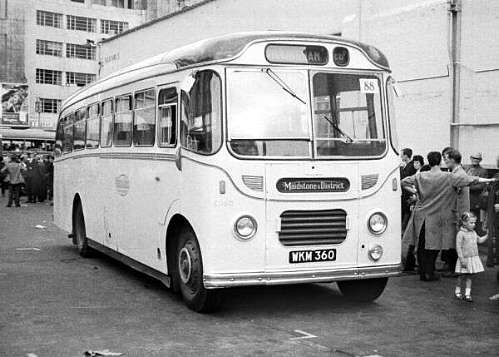
A fine picture of CO360 at Victoria Coach Station, about to depart on a service to Gillingham.
Thanks to Keith Harwood for the photo.
- CO354 (WKM 354) c/n JCB663, deliv.12/55; using components of CO81. Renumbered C354 in 1961. To Transport (Passenger Equipments) Ltd., Macclesfield 12/64. With Tarmac (contractors) 4/66 Cumberland and 8/66 Stockton.
- CO355 (WKM 355) c/n JCB664, deliv.12/55; using components of CO77. Renumbered C355 in 1961. To Transport (Passenger Equipments) Ltd., Macclesfield 3/65. With Willan, Sale 11/65. Dumped at Brooklands, Lancs. 3/67.
- CO356 (WKM 356) c/n JCB665, deliv.12/55; using components of CO83. Renumbered C356 in 1961. To Transport (Passenger Equipments) Ltd., Macclesfield 12/64. With Tarmac (contractors) 1965-66, Cumberland.
- CO357 (WKM 357) c/n JCB666, deliv.12/55; using components of CO75. Renumbered C357 in 1961. To Transport (Passenger Equipments) Ltd., Macclesfield 3/65. To Martin, Northwich 1965. Then with Scully Omnibus Services, Mountmellick, Ireland as DCI 500, by 5/65. To O'Malley, Newport, Ireland 1966. With contractor, Coveray 7/67
- CO358 (WKM 358) c/n JCB667, deliv.12/55; using components of CO76. Renumbered C358 in 1961. To Transport (Passenger Equipments) Ltd., Macclesfield 1/65. With Tarmac (contractors), Wolverhampton 1966. To Aston (dealer), Marton 2/67. In a scrap condition 1968.
- CO359 (WKM 359) c/n JCB668, deliv.12/55; using components of CO62. Renumbered C359 in 1961. To Transport (Passenger Equipments) Ltd., Macclesfield 4/65. To Burnley Welfare Services. With Bamber Bridge Youth Club by 6/71. Winn, Whiston 1/73 to 5/73. Barnsley Multiple Sclerosis Society 7/75.
- CO360 (WKM 360) c/n JCB669, deliv.1/56; using components of CO63. Renumbered C360 in 1961. To Transport (Passenger Equipments) Ltd., Macclesfield 2/65. To Tarmac (contractors) by 4/65.
- CO361 (WKM 361) c/n JCB670, deliv.12/55; using components of CO64. Renumbered C361 in 1961. To Transport (Passenger Equipments) Ltd., Macclesfield 1/65. To Tarmac (contractors) 1965.
- CO362 (WKM 362) c/n JCB671, deliv.12/55; using components of CO65. Renumbered C362 in 1961. To Transport (Passenger Equipments) Ltd., Macclesfield 4/65.
- CO363 (WKM 363) c/n JCB672, deliv.1/56; using components of CO67. Renumbered C363 in 1961. To Transport (Passenger Equipments) Ltd., Macclesfield 2/65. To Tarmac (contractors), Cheshire by 6/65.
- CO364 (WKM 364) c/n JCB673, deliv.1/56; using components of CO68. Renumbered C364 in 1961. To Transport (Passenger Equipments) Ltd., Macclesfield 1/65.
- CO365 (WKM 365) c/n JCB674, deliv.1/56; using components of CO66. Renumbered C365 in 1961. To Transport (Passenger Equipments) Ltd., Macclesfield 11/65. With Tarmac (contractors) by 1966. Scrapped by Gordon (dealer), Amblecote 3/68.
- CO366 (WKM 366) c/n JCB675, deliv.2/56; using components of CO73. Renumbered C366 in 1961. To Transport (Passenger Equipments) Ltd., Macclesfield 11/65. With Tarmac (contractors) 1966. To Gordon (dealer), Amblecote 5/68.
- CO367 (WKM 367) c/n JCB676, deliv.2/56; using components of CO74. Renumbered C367 in 1961. To Transport (Passenger Equipments) Ltd., Macclesfield 3/65.
- CO368 (WKM 368) c/n JCB677, deliv.2/56; using components of CO78. Renumbered C368 in 1961. To Transport (Passenger Equipments) Ltd., Macclesfield 11/65. With Tarmac (contractors) by 5/66.
- CO369 (WKM 369) c/n JCB678, deliv.2/56; using components of CO80. Renumbered C369 in 1961. To Transport (Passenger Equipments) Ltd., Macclesfield 12/64. With James, Tamworth 4/65, withdrawn 7/65. Baxter, Birmingham 9/65, withdrawn 10/66.
- CO370 (WKM 370) c/n JCB679, deliv.2/56; using components of CO82. Renumbered C370 in 1961. To Transport (Passenger Equipments) Ltd., Macclesfield 1/65. With Tarmac (contractors), Upper Carrington by 6/65.
- CO371 (WKM 371) c/n JCB680, deliv.3/56; using components of CO84. Renumbered C371 in 1961. To Transport (Passenger Equipments) Ltd., Macclesfield 3/65. With Tarmac (contractors), Upper Carrington by 6/65.
- CO372 (WKM 372) c/n JCB681, deliv.5/56; using components of CO79. Renumbered C372 in 1961. To Transport (Passenger Equipments) Ltd., Macclesfield 11/65. With Tarmac (contractors), Upper Carrington 1966. At scrapyard, Amblecote 3/68.
- CO373 (WKM 373) c/n JCB682, deliv.4/56; using components of CO69. Renumbered C373 in 1961. To Transport (Passenger Equipments) Ltd., Macclesfield 12/65. With Tarmac (contractors) by 8/66.
- CO374 (WKM 374) c/n JCB683, deliv.4/56; using components of CO70. Renumbered C374 in 1961. To Transport (Passenger Equipments) Ltd., Macclesfield 1/66. With Tarmac (contractors) by 5/66. W.North (dealer), Sherburn-in-Elmet 5/68. Johnson (dealer), Goldthorpe 6/68.
- CO375 (WKM 375) c/n JCB684, deliv.3/56; using components of CO71. Renumbered C375 in 1961. To Transport (Passenger Equipments) Ltd., Macclesfield 12/64. With Tarmac (contractors) by 4/67.
- CO376 (WKM 376) c/n JCB685, deliv.4/56; using components of CO72. Renumbered C376 in 1961. To Transport (Passenger Equipments) Ltd., Macclesfield 12/65. With Tarmac (contractors) by 8/66.
TOTAL 216 ( with 4 survivors - 55, SO9, SO16 and SO26 )
For more Maidstone and District buses see the
Leyland Tigers page.
For many other buses, have a look at all the other profiles on the Classic
Buses menu page.
SOME LINKS WITHIN THIS WEBSITE:
Home
Email
Links
THE COMPLETE WEBSITE MENU
Events Diary
Halfcab list
Small-Ads
Classic Irish Buses
Classic Manx Buses
SB























